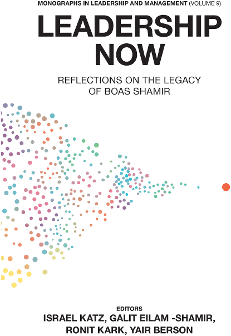
Index
Leadership Now: Reflections on the Legacy of Boas Shamir
ISBN: 978-1-78743-201-7, eISBN: 978-1-78743-200-0
ISSN: 1479-3571
Publication date: 5 October 2018
Citation
(2018), "Index", Katz, I., Eilam-Shamir, G., Kark, R. and Berson, Y. (Ed.) Leadership Now: Reflections on the Legacy of Boas Shamir (Monographs in Leadership and Management, Vol. 9), Emerald Publishing Limited, Leeds, pp. 325-334. https://doi.org/10.1108/S1479-357120180000009010
Publisher
:Emerald Publishing Limited
Copyright © 2018 Emerald Publishing Limited
INDEX
- Prelims
- Introduction: From Leader-Centric to Collective Leadership
- Part I. Leader-Centric Approaches
- Chapter 1 The Motivational Effects of Charismatic Leadership: A Self-Concept Based Theory
- Chapter 2 The Rhetoric of Charismatic Leadership: A Theoretical Extension, a Case Study, and Implications for Research
- Chapter 3 “What’s Your Story?” A Life-Stories Approach to Authentic Leadership Development
- Chapter 4 Keeping the Baby While Refreshing the Bathwater: Revisiting the Role of Singular Leadership
- Chapter 5 Charismatic Pygmalion: The Most Effective Leadership Combo
- Part II. The Leader-Follower Relationship
- Chapter 6 The Charismatic Relationship: Alternative Explanations and Predictions
- Chapter 7 The Role of Followers in the Charismatic Leadership Process: Relationships and their Consequences
- Chapter 8 Great Minds Think Alike? Congruence in Leader and Follower Organizational Identification and Perceptions of Leader Charisma
- Chapter 9 Reversing the Lens in Leadership: Positioning Followership in the Leadership Construct
- Part III. The Context of Leadership
- Chapter 10 Social Distance and Charisma: Theoretical Notes and an Exploratory Study
- Chapter 11 Organizational and Contextual Influences on the Emergence and Effectiveness of Charismatic Leadership
- Chapter 12 The Implications of Emotional Distance on Construal Level of Leadership
- Chapter 13 Leadership in Transformation: From Maestro to a Jazz Orchestra
- Part IV. Epilogue
- Chapter 14 Leadership Now: Reflecting on the Legacy of Boas Shamir
- Index